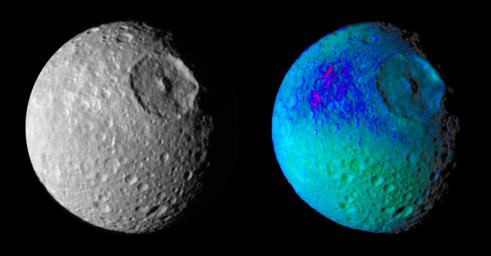
|
Mimas Showing False Colors #1
- Click the image above for a larger view
- Full-Res JPEG (1133 x 590) (68.2 kB)
- Full-Res TIFF (1133 x 590) (2.0 MB)
Caption:
False color images of Saturn's moon, Mimas, reveal variation in either the composition or texture across its surface.
During its approach to Mimas on Aug. 2, 2005, the Cassini spacecraft narrow-angle camera obtained multi-spectral views of the moon from a range of 228,000 kilometers (142,500 miles).
The image at the left is a narrow angle clear-filter image, which was separately processed to enhance the contrast in brightness and sharpness of visible features. The image at the right is a color composite of narrow-angle ultraviolet, green, infrared and clear filter images, which have been specially processed to accentuate subtle changes in the spectral properties of Mimas' surface materials. To create this view, three color images (ultraviolet, green and infrared) were combined into a single black and white picture that isolates and maps regional color differences. This "color map" was then superimposed over the clear-filter image at the left.
The combination of color map and brightness image shows how the color differences across the Mimas surface materials are tied to geological features. Shades of blue and violet in the image at the right are used to identify surface materials that are bluer in color and have a weaker infrared brightness than average Mimas materials, which are represented by green.
Herschel crater, a 140-kilometer-wide (88-mile) impact feature with a prominent central peak, is visible in the upper right of each image. The unusual bluer materials are seen to broadly surround Herschel crater. However, the bluer material is not uniformly distributed in and around the crater. Instead, it appears to be concentrated on the outside of the crater and more to the west than to the north or south. The origin of the color differences is not yet understood. It may represent ejecta material that was excavated from inside Mimas when the Herschel impact occurred. The bluer color of these materials may be caused by subtle differences in the surface composition or the sizes of grains making up the icy soil.
The images were obtained when the Cassini spacecraft was above 25 degrees south, 134 degrees west latitude and longitude. The Sun-Mimas-spacecraft angle was 45 degrees and north is at the top.
Background Info:
The Cassini-Huygens mission is a cooperative project of NASA, the European Space Agency and the Italian Space Agency. The Jet Propulsion Laboratory, a division of the California Institute of Technology in Pasadena, manages the mission for NASA's Science Mission Directorate, Washington, D.C. The Cassini orbiter and its two onboard cameras were designed, developed and assembled at JPL. The imaging operations center is based at the Space Science Institute in Boulder, Colo.
For more information about the Cassini-Huygens mission visit http://saturn.jpl.nasa.gov . The Cassini imaging team homepage is at http://ciclops.org .
Cataloging Keywords:
| Name | Value | Additional Values |
|---|---|---|
| Target | Mimas | |
| System | Saturn | |
| Target Type | Satellite | |
| Mission | Cassini-Huygens | |
| Instrument Host | Cassini Orbiter | |
| Host Type | Orbiter | |
| Instrument | Imaging Science Subsystem (ISS) | |
| Detector | Narrow Angle Camera | |
| Extra Keywords | Color, Crater, Impact, Infrared, Map, Ultraviolet, Visual | |
| Acquisition Date | ||
| Release Date | 2005-08-05 | |
| Date in Caption | 2005-08-02 | |
| Image Credit | NASA/JPL/Space Science Institute | |
| Source | photojournal.jpl.nasa.gov/catalog/PIA06257 | |
| Identifier | PIA06257 | |
